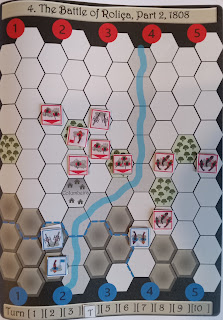A French army under General Jean-Andoche Junot attacked, but was defeated by, Sir Arthur Wellesley's men.
 |
| In the fifth scenario in Mike Lambo's Battles Of Napoleonic Europe, the Allies advance from the bottom of the map and have to be holding the village of Vimeiro at the end of turn 10 |
 |
| My plan is to advance across the hill next to Vimeiro with three units of infantry, my cavalry and Wellesley |
I realise my plan may have to change, depending on the initial disposition of the French forces.
General Junot - the book wrongly describes him as Marshal a title Napoleon denied him, not least because of his defeat at Vimeiro - has eight units of infantry, two of cavalry and one of artillery.
 |
| The French infantry and artillery start in assigned hexes, but the placement of the cavalry and Junot is diced for |
My activation dice land 6, 5 and 3. I reroll the 5, but get another 3. I change the wildcard 6 into a 4.
I advance my main body of infantry obliquely forward to their right, and the cavalry two hexes in the same direction.
The AI's four dice land 6, two 4s and 2. The 6 and a 4 are rerolled, giving another 4 and 3.
The cavalry in area 2 roll 3, advancing two hexes. The infantry in area two advance, although the further-forward unit does it obliquely to their left.
Both units in area 3 roll 3, but only one can follow the instruction of advancing straight down.
The cavalry in area 4 roll 2, which would only result in movement if there were enemy within three hexes. The infantry in area 4 also roll 2, which results in them moving nearer to Vimeiro.
The artillery roll 6 but cannot follow the instruction of moving straight down. Junot advances so he is adjacent to four friendly units.
 |
| The first clash of arms should occur next turn |










.jpg)


































.jpg)